Amazon
- Amazon is an electronic commerce company.
- Founded in 1994 in Bellevue.
- Founder and CEO: Jeff Bezos.
- Initially was an online bookstore.
- Amazon quickly diversified their business selling a wide variety of goods.
- Produces electronics (Kindle e-book, Fire tablets and phones).
- Today Amazon is one of the world’s largest online retailers.
Amazon started their business being a small book selling business. Initially, the business operated from a garage where people were manually packing and shipping books. The table they used for packing books was fashioned with the help of a door that was not used. Nowadays, the business has been operating for 20 years and it is one of the largest and most profitable online retailing businesses in the world. Amazon quickly expanded and started to sell goods other than books. The range of items sold on Amazon includes electronics, clothes, food, jewelry, and furniture, among others.
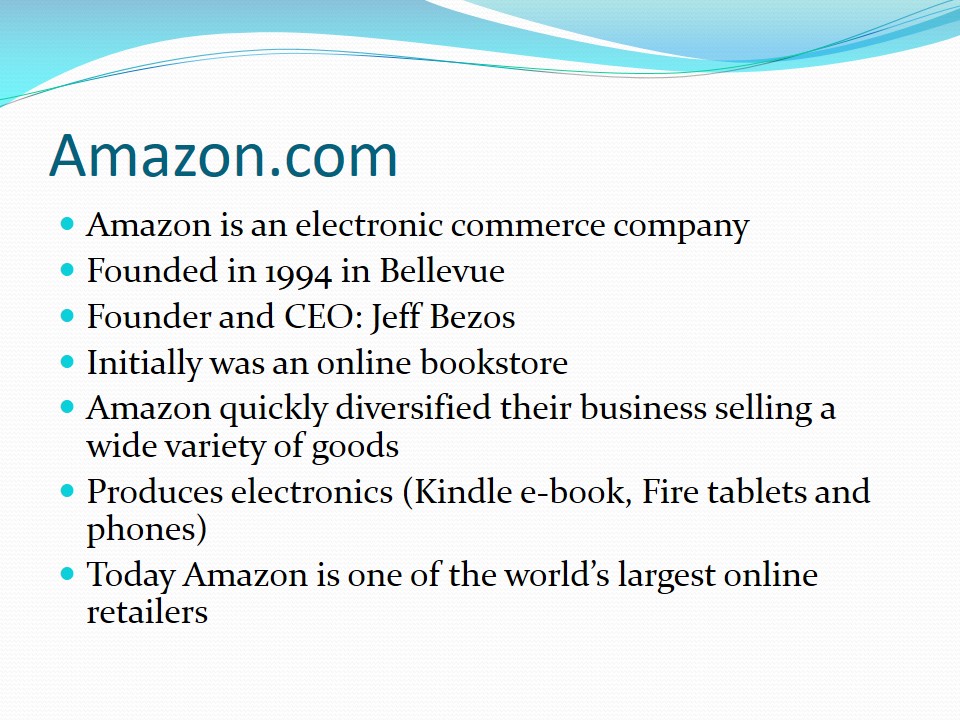
Profit and Success
- The progress made by Amazon is stable and sufficient.
- 11% profit during recession.
- Amazon’s shares have grown by 18% after the company reported a surprise profit.
- Sales rose by 20% in the end of June.
- Forecasted growth between 13 and 24% compared to last year.
- Outstanding success in North America (25% growth of sales compared to last year).
Amazon has customers all around the world. It is especially popular in North America. The company has an incredibly strong performance, its sales showed an 11% growth even during the period of recession (2008 – 2009) (Webley par. 1).

3 Steps of Amazon’s Innovation
- The use of the Internet and its immense popularity as a resource.
- The cooperation with their party sellers.
- Targeting the IT community through their web service platform.

Amazon’s Service Innovation
- Advanced services for the customers with the help of the new technologies.
- Service innovation is closely connected to the technological progress and change.
- Amazon uses the huge popularity of the internet to expand their business and maximise revenues.
- The company targets markets that are untapped yet.
- Amazon employs the latest technologies to move their business forward and present a stronger competition.
The type of innovation used by Amazon is service innovation that relies on the technological development as the means to improve and expand the services. The internet boom that has been happening for the last couple of decades is extremely helpful for the business.
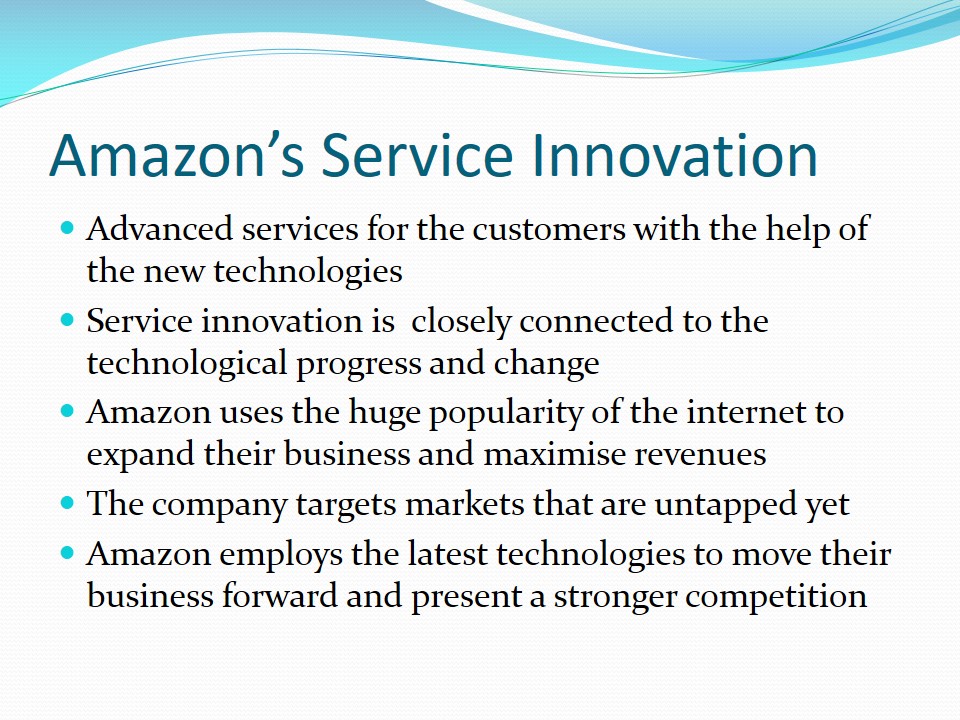
Amazon’s Business Model
- Innovative business model is the main source of surging shares of Amazon.
- Initially – commission was earned from brokerage service.
- Later – partnership with the competitors (third party sellers).
The reason for the surging revenue of Amazon.com is its innovative business model. Amazon.com initially, earned its revenue from the commissions from its brokerage service to buyers and sellers. Later they moved on to serve third-party sellers, who were essentially the company’s competitors, to sell through their website and earning commission in the process (Johnson par. 4).
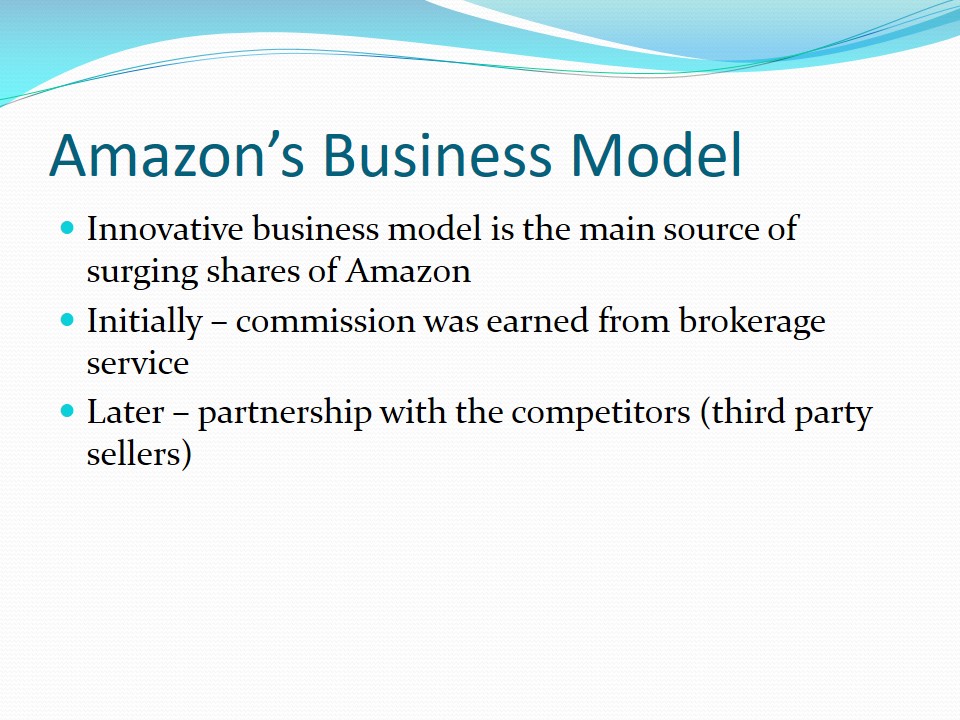
Ongoing Diversification
- Engaging the IT community through the web service platform.
- Production of Kindle e-book for the reading enthusiasts.
- Online retailing + B2B relationships with other sellers.
- Development of the cloud platform for the customers.
Amazon never stopped innovating and transforming their business in order to target new groups of customers, engage new resources, and remain different and thus, more demanded than its competitors. Kindle e-book alone is a good example of diversification as a product and service offering (Johnson par. 5). Due to its constant diversification of services, strategies, and target customers, Amazon is basically impossible to copy.

Amazon’s Cloud Computing
- Highly novel technological product, introduced to the market very recently.
- Allows customers to subscribe and use a domain and run any application on it as well as store data, paying for their usage.
- Cloud computing division brings 80 % revenue increase in 2014-2015.
- Cloud technology is not widely used yet, so it limits the competition for Amazon.
Cloud computing is a novel technology which is being experimented by many companies like Microsoft and Google. Cloud computing provides its customers a pay-per-use and self-service model via the Internet. Thus, cloud computing helps create business value and increase technology enabled business innovation. The cloud platform offered by Amazon provides its customers with a unique platform where they can use any operating system of a computer that works virtually, and store their data in the virtual storage provided with by the company. The customers have to subscribe to the cloud services provided by Amazon and continue using the product with little or no hassle. Due to the novelty of the cloud computing technology the only strong competitors of Amazon in this sphere are Google and Microsoft. Using this untapped resource Amazon is able to increase its revenue and attract a wider customer base.
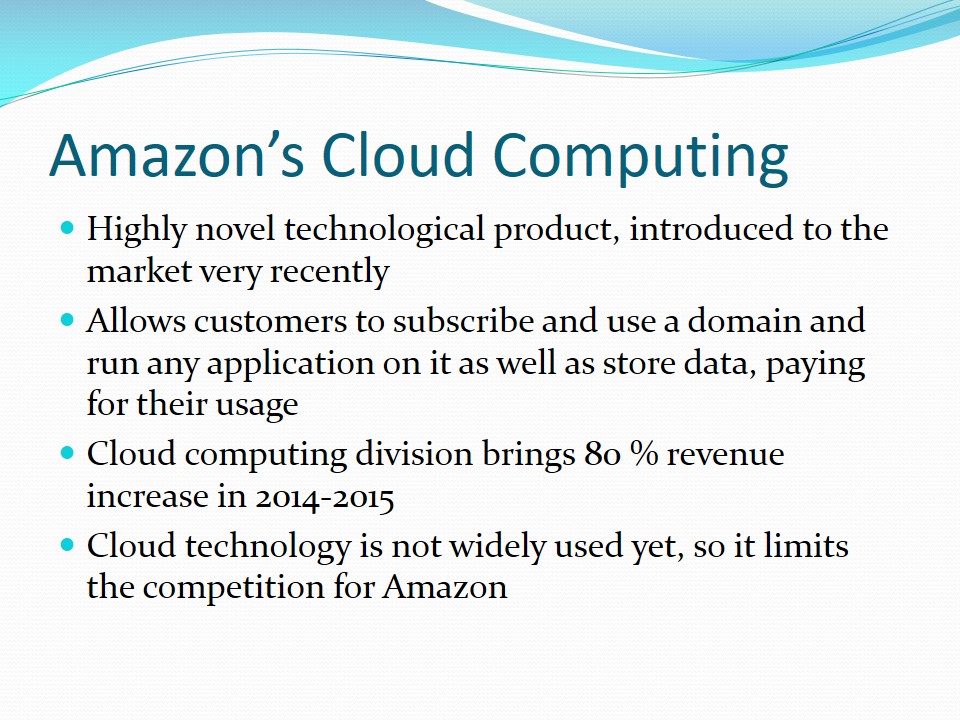
Value of Cloud Computing
- Elastic Cloud Computing (EC2):
- Provides infrastructure as a service to the customers.
- Attract customers who face the problems with high traffic in the internet (Siegel and Gibbons 9).
- Elastic IP addresses, thus attracting web hosting market.
- Simple Storage Service (S3):
- Provides users with highly scalable, fast, inexpensive, data storage infrastructure.
- Easy access to data stored in the cloud.
The cloud computing service of Amazon is divided into two categories – Elastic Cloud Computing (EC2) and Simple Storage Service (S3). Elastic Cloud Computing helps customers rent a machine on the web in order to boost web-scale computing (Rouse par. 3). Simple Storage Service allows the clients of Amazon to work with their data kept in the cloud accessible from anywhere on the web.
The cloud platform provides a unique opportunity to make inroads into an emerging market with the aid of a nascent technology. The target customers of Amazon for its EC2 and S3 services are mostly small start-ups who receive great value for the services they subscribe for and larger companies.
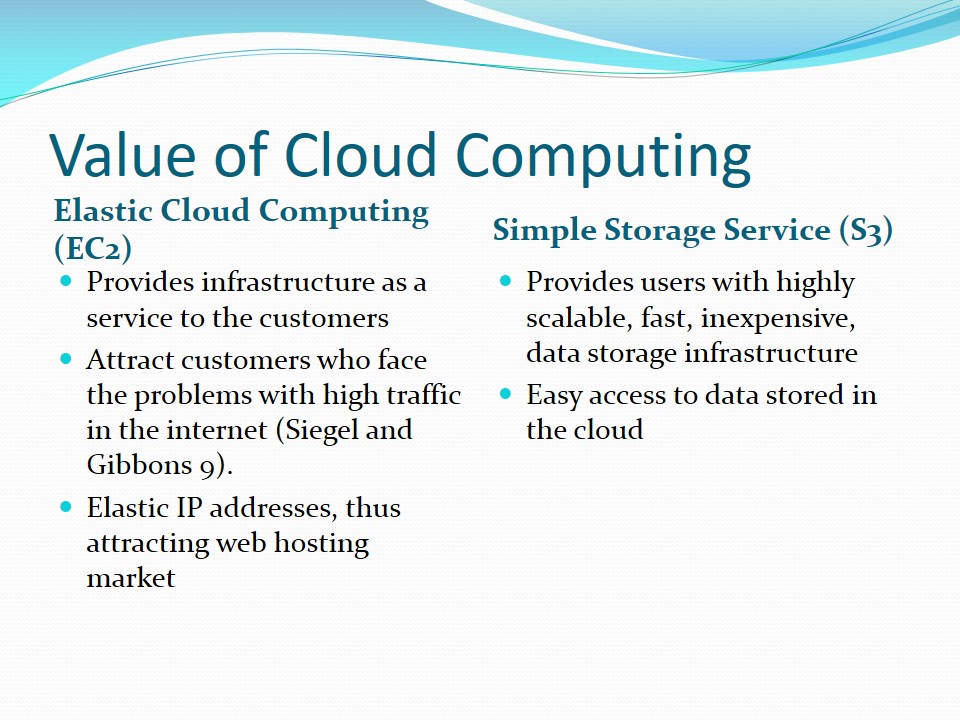
Theory of Innovation Applied to Amazon’s Cloud Computing
- The technology S-curve life cycle:
- A new technology (such as the cloud) is marketed while it is at the top of its popularity and novelty.
- While the development of the technology is possible it is explored as a resource.
- As the technology matures, its development slows down and so does the growth, so the new resource technology is needed.
The company’s business model remains the same as before. The only change observable is in the product/service that Amazon provides. The company provides the infrastructure that helps other companies to process, access, use, and store data with minimum subscription.
S-curve life cycle consists of the growth and steep slope of the curve. Amazon’s cloud platform is presently in the rising portion of the S-curve indicating space for future growth.
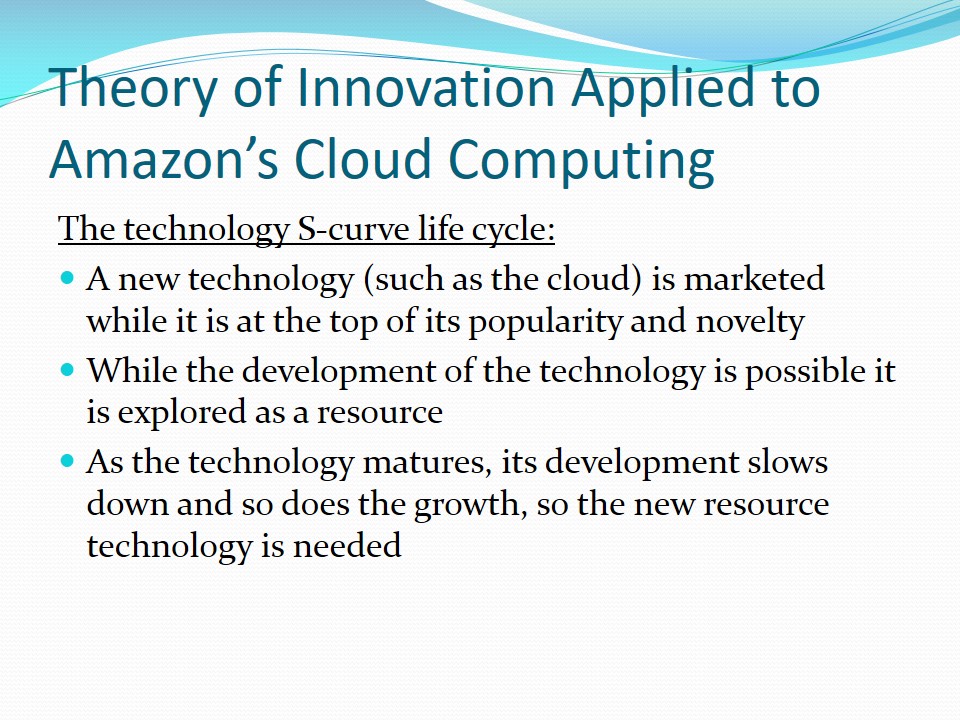
Cloud Technology and Competition
- Limited number of competitors due to the novelty of the technology.
- Need for the improvement of the product offerings due to the existing competition.
- Search for punctuated equilibrium – a point of stability in innovation.
- Amazon is trying to cover a larger customer base (big and small businesses).
Currently, Amazon is targeting big and small companies trying to facilitate their investments into the use of the cloud services, but the punctuated equilibrium (an optimal comfort level for both the company and the customers) has not been achieved yet.
Amazon has diversity of experience and exposure to prior related knowledge in providing great value to its customers. The cloud platform allows Amazon to increase its absorptive capacity and enhance their online retail business.

Works Cited
Johnson, Mark W. Amazon’s Smart Innovation Strategy. 2010. Web.
Rouse, Margaret. Amazon Elastic Compute Cloud (Amazon EC2). 2010. Web.
Siegel, Micah and Fred Gibbons 2008, Amazon Enters the Cloud Computing Business. Web.
Webley, Kayla. Online Shopping. 2010. Web.